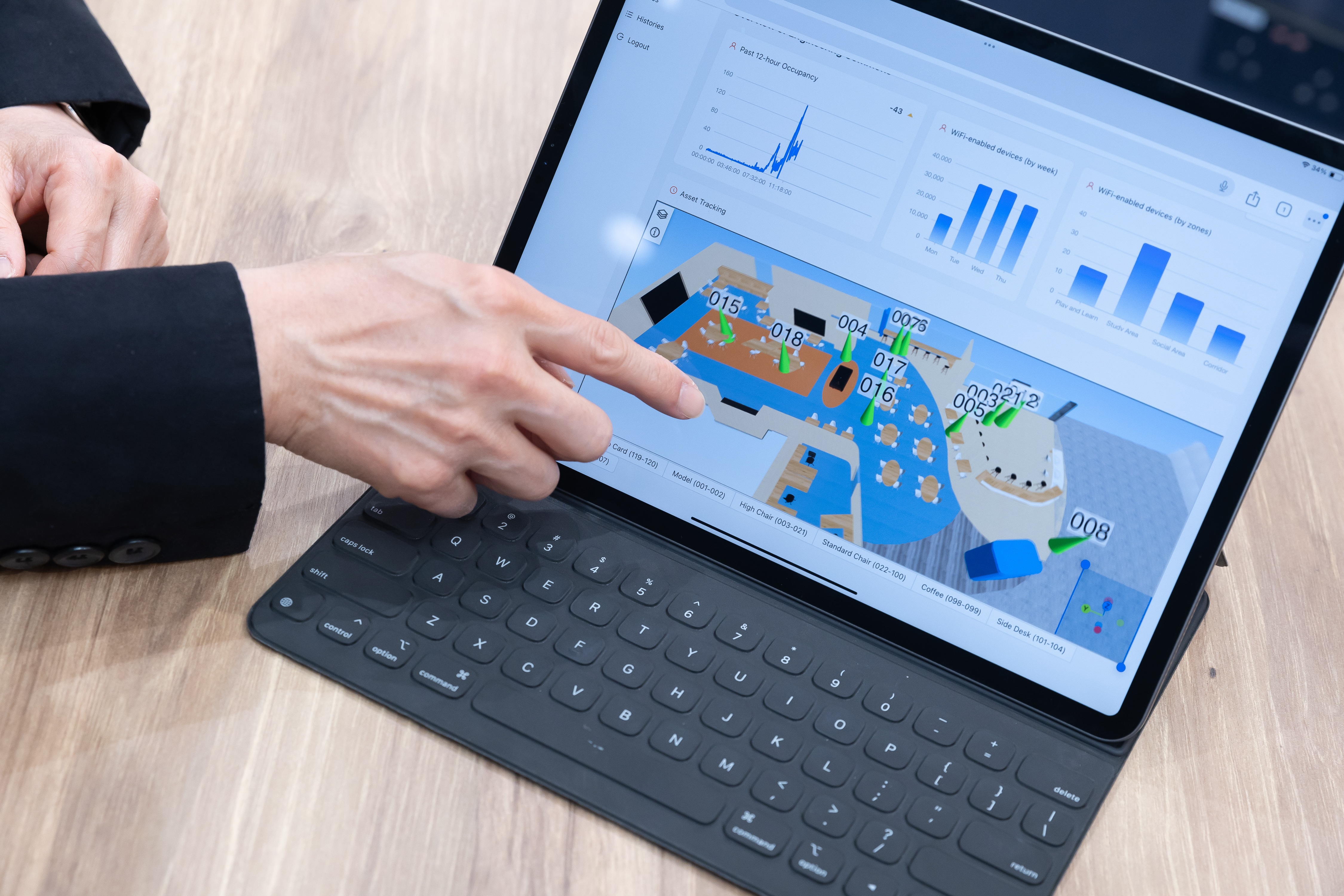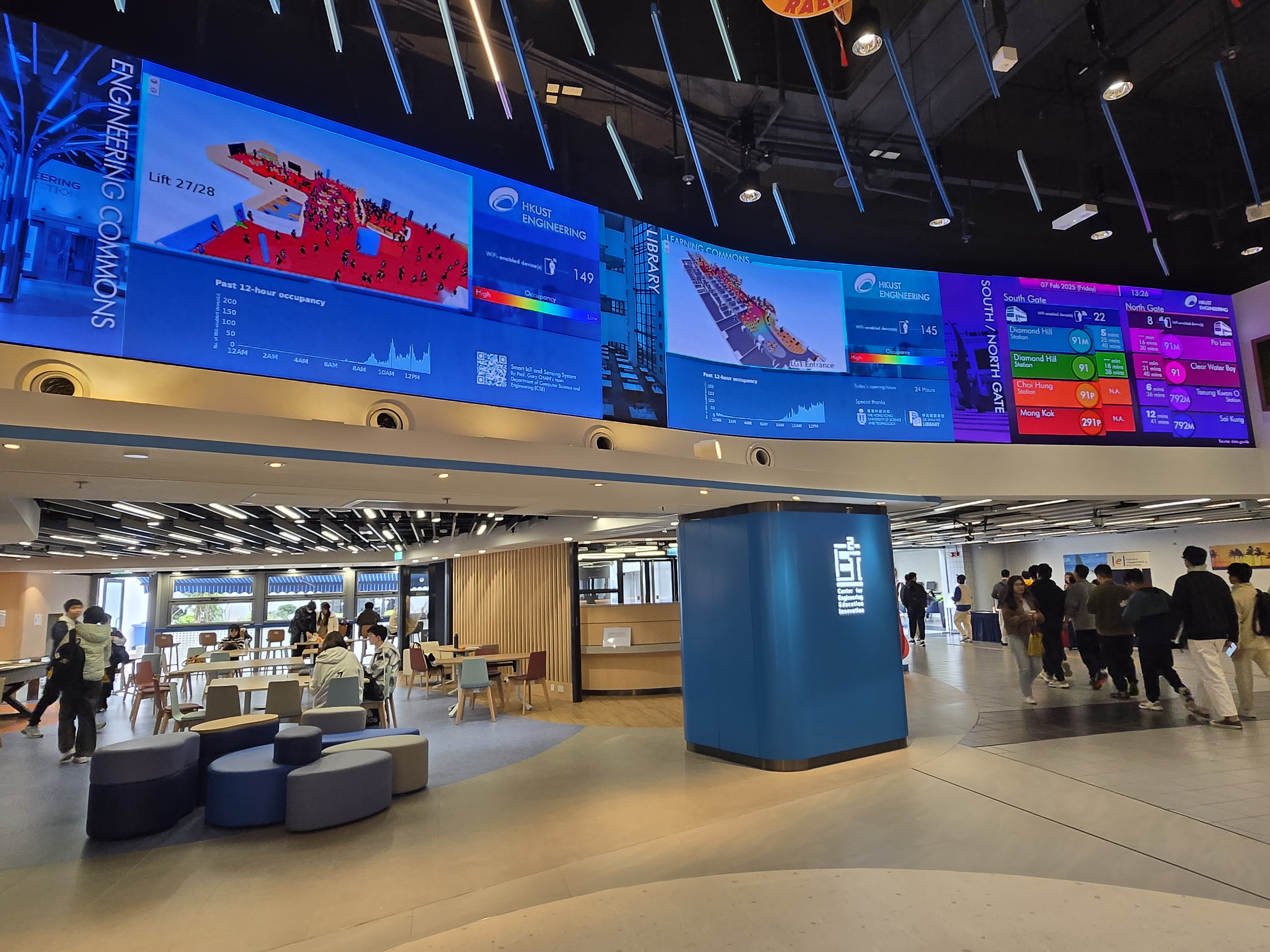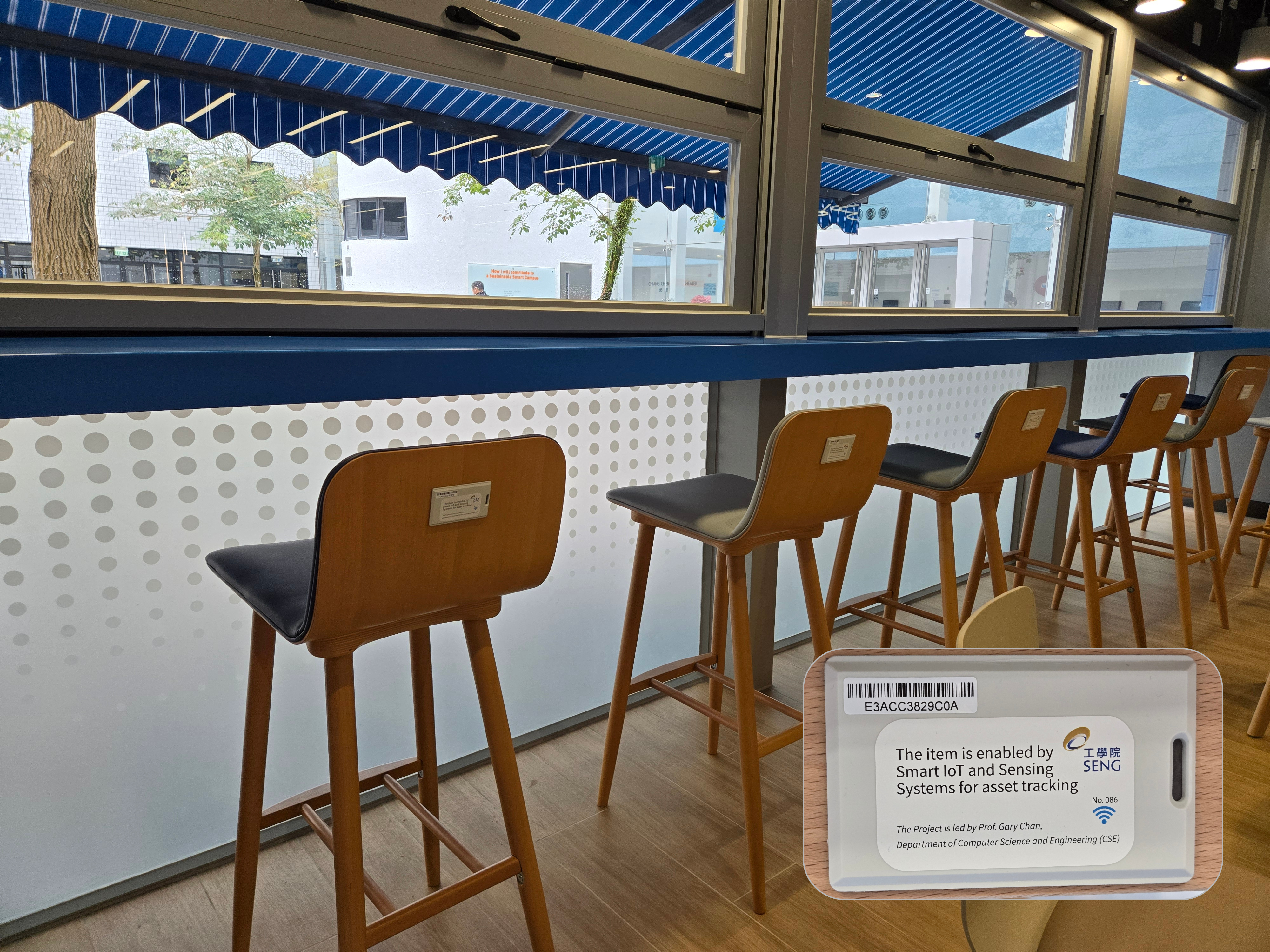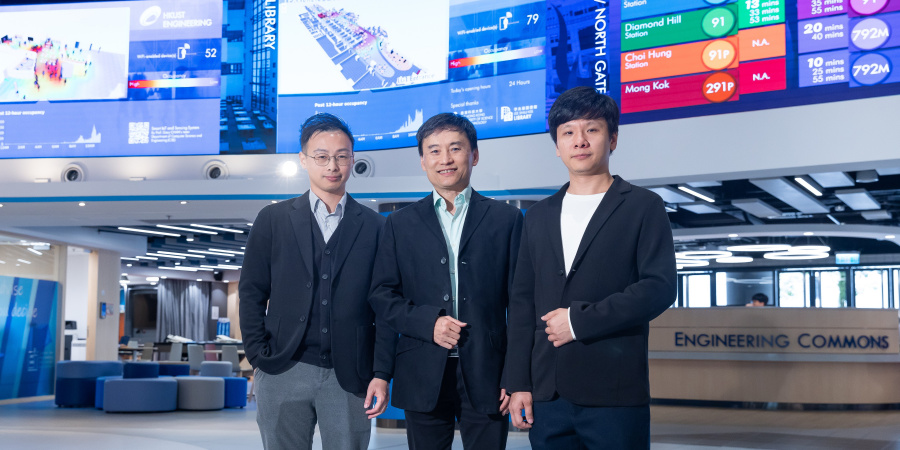HKUST Community Benefits from Award-Winning AIoT Project to Estimate Queue Status and Occupancy
HKUST’s Engineering Commons, opened in 2013, has been the School of Engineering’s “family room” that enhances interaction of the engineering community and enables the display of top-notch research of its faculty members. Located at a key intersection of the campus, the Engineering Commons was renovated in 2024 after being used for more than a decade. As the Commons officially reopened in October 2024, it features an array of new research applications that are most relevant to campus life, including AIoT sensing research led by Prof. Gary CHAN Shueng-Han of the Department of Computer Science and Engineering.
After class and work, HKUST students and staff no longer need to walk all the way to the two campus entrances before finding out how long they need to wait for buses and minibuses. They only need to lift their heads to glimpse at the huge LED walls at the center of the campus, or simply click onto the university’s website, to learn about queue status so as to make better plans and optimize their outgoing trips. The LED display also makes available the occupancy of selected study space at the university’s Lee Shau Kee Library, as well as the Engineering Commons outside which the LEDs are located.
This is not only about real-time data provided by bus companies. Most importantly, they are the results of HKUST’s award-winning AIoT* (Artificial Intelligence of Things) research that enables precise IoT (Internet of Things) people sensing for the estimation of people count.
* The combination of AI and IoT
ITF project benefiting society
Prof. Gary CHAN, Professor of the Department of Computer Science and Engineering, elaborated on the technology developed from the IoT or RF (radio frequency) sensing project that won the Innovation and Technology Fund (ITF) recognition in 2015. With the theme of “Smart AP: Wi-Fi Positioning and Optimization for a Smart City” (in which AP stands for access point), the project was to research, develop and deploy novel Wi-Fi technology with highly accurate device localization and sensing, such that it can be used in crowd analysis and management.
“With Wi-Fi sensing, we can know the number of mobile devices in a designated area, and thus estimate the actual number of people there. There is a challenge however, that each Wi-Fi-enabled device emits a virtual hardware address which changes over time. For Wi-Fi sensing, if we just count the number of distinct virtual hardware addresses, it may result in an over-estimation of people count. To solve this problem, we have achieved a research breakthrough with a technology that correlates these distinct virtual addresses to the same device. In so doing, we can achieve high accuracy in estimating the number of devices in the system.”
With upgrades further to the breakthrough, the HKUST home-grown technology is now being commissioned in shopping arcades, cruises and even marathons. “We can estimate the number of people waiting for lavatories and for discounted parking vouchers at shopping centers. At marathons, we can learn about the flow of runners, or if runners have gone off track.”
Such are the yields of Prof. Chan’s 20-member research and development team that resembles a company. Dr. LAI Ki-Kit, Manager of Innovation and Product Development, oversees projects and liaises with industry partners, government contacts and clients to coordinate resources, allocate tasks, manage schedules and ultimately ensure deliverables. Jerry LIN Zhongming, Assistant IT Manager, works in the front line to lead a strong team of engineering members with lists of working items and steps to develop IT solutions. Whereas postgraduate students conduct advanced research, undergraduate students package research findings into software modules. In so doing, students work together to turn research ideas into practical impacts.
Maintaining long-term collaborations with users and clients, the team regularly provides reports through its analytics platform with an easy-to-use user interface in the form of dashboards with flow charts, which could be generated on hourly, daily, weekly or monthly basis according to specific user requirements.

The AIoT sensing project’s analytics back-end platform provides reports via an easy-to-use user interface in the form of dashboards with flow charts.
Display for HKUST community
From deployment, client liaison, user interface to data visualization, the team and technology have matured over the years. Thus, in late 2024 when the School of Engineering approached Prof. Chan’s team to use the technology in the Engineering Commons, there was little need for further upgrades or modifications.
The School aspired to install huge LED walls to display three important pieces of information. Firstly, they show data about the queue status of buses and min-vans at the north and south gates of the campus. On top, they reflect the occupancies at both the university library’s Learning Commons and floor LG5, so that students can know, and hence easily find, available seats. Lastly, it shows the crowd analysis at the Engineering Commons, for example people flow on major university events such as Information Day. Further to students’ request and enthusiastic response, Prof. Chan’s team shared the information on the university’s website for convenient access (https://eek123.ust.hk/iotsensing/).
Privacy preservation is of the top priority. “By working with virtual map addresses only, there is no personal information involved. All data remains anonymous,” Prof. Chan noted.
 The LED walls at the Engineering Commons make available the queue status at the university entrances and occupancy of selected study space on campus.
The LED walls at the Engineering Commons make available the queue status at the university entrances and occupancy of selected study space on campus.
Tracking people and assets
Beyond people sensing, another significant AIoT application is the tracking of assets. Most recently at HKUST’s Engineering Commons, Prof. Chan’s team adheres Bluetooth tags on portable furniture and equipment including the valuable robotic coffee machine. With these, the School is now able to accurately track the location and last appearance of such items to learn about students’ preferences and ensure security.

The photo shows the Bluetooth tags affixed to the back of the chairs at the Engineering Commons, with a close-up image of the tag in the bottom right corner.
There was a challenge to be overcome. For Bluetooth-tagged assets, the signals emitted by the tags are noisy. To work against the complex environment and obstacles, the team proposed using machine learning to accurately estimate the asset location. The solution now enables robust and precise proximity estimation despite the noisy environment.
Community-minded research and down-to-earth technologies
In fact, Prof. Chan’s team has widely adopted the AIoT technology in the community to help search for missing dementia patients. They launched the Dementia’s Secret Angel app called CCMC (Caring Community for MIP Campaign) and low-cost tags in 2022. Working with NGOs and the police, they have equipped Bluetooth tags for more than 3,500 people with mental incapacity. If lost, wandering people can be located by angels (the police and members of the public) who have downloaded the app on smartphones with Bluetooth and GPS on. The work won a gold award at the Hong Kong ICT Awards 2022.
The team has also contributed to asset tracking and geofencing at the Tseung Kwan O Hospital so as to track dementia patients, portable hospital beds and medical equipment alike.
It is not a coincidence that the community-minded Prof. Chan developed innovative geofencing technology Signature Home which was pivotal in the government’s StayHomeSafe mobile app to enforce compulsory home quarantine during COVID-19. For his technology, he received the Chief Executive’s Commendation for Community Service in 2020 for outstanding contribution to the fight against COVID-19. His team’s SafeOne system based on privacy-preserving edge AI camera, which safeguards singleton elderly people and facilitates the act of taking care of them, also won a silver award at the Hong Kong ICT Awards 2024.
Prof. Chan has co-founded several start-ups with international accolades. As the former Director of the Entrepreneurship Center at HKUST, he possesses solid experience in technology transfer and industry collaborations.
“At Engineering Commons, our project helps participating undergraduate students learn about the significance of applying our research findings in real life.” The professor, with strong beliefs in the applied value and practical impacts of research, remarked, “Overcoming the gap between fundamental theories and applications is challenging but rewarding. From upstream research to downstream deployment, the last mile can be excruciatingly far. It has to be bridged with substantial effort, or else the research results would not leave the lab to see the light in the world.”
His PhD education at Stanford University close to the Silicon Valley nurtured in him the passion to create economic and social value with technology. More specifically, his Christian faith has led him to care especially for the needy, and thus his projects associated with healthcare and social well-being.
“I believe that whatever in our lives does not happen as coincidences. They occur for a purpose. To me, my purpose is to help people and advance our living through my research. For the underprivileged or disadvantaged, I want them to know that they are being cared for and loved, since the greatest of all is love.”
He truly walks the talk of his research.

